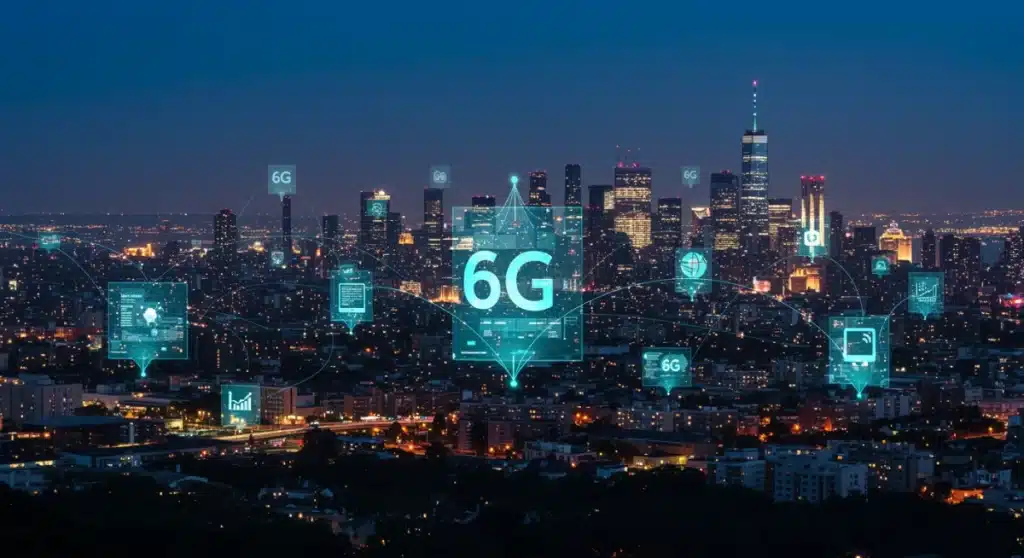6G to Reshape US Communication by 2030, 50x Speed Boost

The Evolution of Connectivity: How 6G Will Reshape US Communication by 2030, Increasing Speeds by 50x is set to fundamentally transform digital interactions, promising unprecedented speeds and capabilities across all sectors.
The digital landscape is on the brink of a monumental transformation. The Evolution of Connectivity: How 6G Will Reshape US Communication by 2030, Increasing Speeds by 50x is no longer a distant concept but a rapidly approaching reality, promising to redefine how we interact with technology and each other. Are we ready for a future where data moves at unimaginable velocities?
The Dawn of 6G: Beyond Current Limitations
The transition from 5G to 6G represents more than just an incremental upgrade; it signals a paradigm shift in wireless communication. While 5G brought enhanced mobile broadband and lower latency, 6G aims to push boundaries far beyond, introducing capabilities that will enable truly immersive and intelligent environments. This next generation of connectivity is expected to deliver speeds up to 50 times faster than its predecessor, fundamentally altering the fabric of US communication by 2030.
As of recent developments, global research consortiums and major tech players are accelerating their efforts in 6G development. The focus is not only on raw speed but also on integrating artificial intelligence, advanced sensing capabilities, and ubiquitous connectivity into the core network architecture. This holistic approach ensures that 6G will not merely be a faster network but a smarter, more responsive, and incredibly versatile platform.
Key Technological Leaps for 6G
- Terahertz Frequencies: Utilizing higher frequency bands to achieve unprecedented data rates and massive bandwidth.
- AI-Native Air Interface: Integrating artificial intelligence directly into the network’s core for dynamic optimization and enhanced performance.
- Integrated Sensing and Communication: Enabling networks to not only transmit data but also sense their environment, supporting precise localization and imaging.
- Reconfigurable Intelligent Surfaces (RIS): Deploying smart surfaces that can intelligently reflect and refract wireless signals to improve coverage and efficiency.
These technological advancements are critical for realizing the ambitious goals of 6G, paving the way for applications that are currently theoretical. The implications for industries ranging from healthcare to manufacturing are profound, promising an era of hyper-connectivity and real-time data processing.
Unprecedented Speed and Ultra-Low Latency
The promise of 6G hinges significantly on its ability to deliver unparalleled speeds and ultra-low latency. Imagine downloading an entire high-definition movie in seconds or experiencing virtual reality with absolutely no perceptible delay. These are the kinds of capabilities that 6G is designed to offer, with theoretical peak speeds projected to reach terabits per second.
This massive leap in speed, approximately 50 times faster than current 5G networks, will unlock new possibilities for data-intensive applications. From advanced scientific research requiring instant data transfer to real-time genomic sequencing, the infrastructure provided by 6G will be a cornerstone of future innovation. The capacity to handle enormous volumes of data with minimal delay will also be crucial for the widespread adoption of technologies like holographic communication and digital twins.
Impact on Data-Driven Industries
- Healthcare: Enabling remote surgery with haptic feedback and instant transfer of high-resolution medical imagery.
- Manufacturing: Powering fully autonomous factories with real-time process control and predictive maintenance.
- Entertainment: Delivering truly immersive augmented and virtual reality experiences without lag.
- Transportation: Facilitating vehicle-to-everything (V2X) communication for enhanced safety and autonomous driving.
The ultra-low latency characteristic of 6G, expected to be in the microsecond range, will be just as transformative as its speed. This will allow for instant responses from connected devices, critical for applications where even a millisecond of delay can have significant consequences, such as in autonomous systems and remote-controlled robotics. The combination of speed and responsiveness will create a new foundation for digital interaction.
Transforming Industries: From Smart Cities to Healthcare
The impact of The Evolution of Connectivity: How 6G Will Reshape US Communication by 2030, Increasing Speeds by 50x extends far beyond individual user experience; it promises a complete overhaul of various industries. Smart cities, for instance, will become truly intelligent, with interconnected sensors, traffic management systems, and public services operating in perfect synchrony, driven by the instantaneous data processing capabilities of 6G.
In healthcare, 6G will enable a new era of precision medicine and remote care. Doctors could perform complex surgeries remotely with real-time haptic feedback, while massive datasets from wearable sensors and medical devices could be analyzed instantly by AI, providing personalized health insights. This level of connectivity will democratize access to advanced medical care, especially in underserved areas.
Industry-Specific Innovations with 6G
Beyond smart cities and healthcare, other sectors are also poised for radical transformation:
- Agriculture: Precision farming using AI-powered drones and sensors for optimal crop yield and resource management.
- Logistics: Real-time tracking and management of supply chains, enabling autonomous delivery systems and highly efficient warehousing.
- Education: Immersive learning environments with holographic teachers and interactive virtual classrooms, accessible globally.
The integration of AI with 6G networks will create adaptive and self-optimizing systems that can predict needs and allocate resources more efficiently. This will lead to unprecedented levels of automation and intelligence across all sectors, driving economic growth and societal advancement. The sheer volume of data generated and processed will require robust security measures, a critical aspect of 6G development.

The Role of AI and Machine Learning in 6G
Artificial Intelligence (AI) and Machine Learning (ML) are not just complementary technologies to 6G; they are integral to its very architecture and operation. Unlike previous generations where AI was often an add-on, 6G networks are being designed from the ground up to be AI-native. This means AI will be embedded in every layer of the network, from signal processing and resource allocation to network management and security.
The integration of AI will allow 6G networks to be incredibly adaptive and efficient. They will be able to predict traffic patterns, optimize resource distribution in real-time, and even self-heal in response to outages. This level of intelligence is crucial for managing the immense complexity and scale of 6G, especially when dealing with terahertz frequencies and massive numbers of connected devices. AI will enable dynamic spectrum sharing, ensuring optimal use of available bandwidth and reducing interference.
AI-Driven Network Optimization
- Predictive Maintenance: AI algorithms will anticipate network failures, allowing for proactive maintenance and preventing service disruptions.
- Dynamic Resource Allocation: Networks will intelligently allocate bandwidth and power based on real-time demand, ensuring seamless performance.
- Enhanced Security: AI will detect and mitigate cyber threats with greater speed and accuracy, protecting sensitive data.
- Personalized Services: AI will enable networks to tailor connectivity and services to individual user needs and application requirements.
Furthermore, 6G will facilitate the proliferation of distributed AI, where AI computations are performed closer to the data source at the network edge. This reduces latency and enhances privacy, enabling real-time AI applications such as autonomous systems and advanced robotics without relying on centralized cloud processing. The synergy between 6G and AI will create a truly intelligent communication ecosystem.
Security and Privacy in the 6G Era
As The Evolution of Connectivity: How 6G Will Reshape US Communication by 2030, Increasing Speeds by 50x ushers in an era of hyper-connectivity, the challenges of security and privacy become paramount. With billions of devices exchanging vast amounts of sensitive data, robust security measures are not just desirable but absolutely essential. 6G networks are being designed with security as a foundational element, rather than an afterthought.
Key security enhancements in 6G will include quantum-resistant cryptography to protect against future quantum computing attacks, enhanced identity management for devices and users, and advanced threat detection using AI. The distributed nature of 6G, with edge computing and decentralized architectures, could also offer new opportunities for privacy-preserving technologies, such as federated learning, where AI models are trained on local data without it ever leaving the device.
Addressing Key Security Concerns
- Quantum-Resistant Cryptography: Implementing new encryption standards to withstand quantum computing threats.
- Enhanced Device Authentication: More robust identity verification for the massive influx of connected devices.
- AI-Powered Threat Detection: Utilizing machine learning to identify and respond to cyber threats in real-time.
- Privacy by Design: Integrating privacy controls directly into the network architecture and protocols.
The sheer volume and variety of data flowing through 6G networks will also necessitate new approaches to privacy. Regulatory frameworks will need to evolve to keep pace with technological advancements, ensuring that user data is protected while still enabling the benefits of hyper-connectivity. Transparent data governance and user control over personal information will be critical components of a trusted 6G ecosystem. The development of secure and private 6G infrastructure is a collaborative effort involving governments, industry, and academia.
Global Race for 6G Dominance and US Strategy
The development of 6G is not just a technological pursuit but a global strategic race, with nations vying for leadership in this next-generation wireless frontier. The United States is actively investing in research and development, recognizing that early leadership in 6G will have significant economic and national security implications. Collaborations between government agencies, academic institutions, and private companies are crucial to accelerating progress and ensuring US competitiveness.
Key initiatives include funding for fundamental research into terahertz communications, advanced materials, and AI integration. The goal is to establish a robust ecosystem for 6G innovation, fostering the development of new standards, intellectual property, and cutting-edge applications. International partnerships are also vital, as 6G, like its predecessors, will require global standardization to ensure seamless interoperability.
Pillars of US 6G Strategy
- Research & Development Investment: Allocating significant funds to universities and private labs for foundational 6G technologies.
- Talent Development: Investing in STEM education and training to cultivate a skilled workforce for 6G innovation.
- International Collaboration: Engaging with allies and partners to shape global 6G standards and foster interoperability.
- Spectrum Allocation: Identifying and making available suitable frequency bands for future 6G deployments.
The race for 6G dominance is expected to intensify in the coming years, with significant geopolitical implications. Countries that lead in 6G development will likely set the global standards, influence future technological trajectories, and gain a competitive edge in various industries. The US strategy is focused on fostering innovation domestically while also engaging internationally to ensure an open, secure, and interoperable global 6G environment. This proactive approach is essential for realizing the full potential of The Evolution of Connectivity: How 6G Will Reshape US Communication by 2030, Increasing Speeds by 50x.
| Key Aspect | Brief Description |
|---|---|
| Speed & Latency | Up to 50x faster than 5G, ultra-low latency in microseconds, enabling real-time applications. |
| AI Integration | AI-native network architecture for dynamic optimization, predictive maintenance, and enhanced security. |
| Industry Impact | Revolutionizing healthcare, smart cities, manufacturing, and transportation with hyper-connectivity. |
| Security & Privacy | Foundational quantum-resistant cryptography, AI-powered threat detection, and privacy by design. |
Frequently Asked Questions About 6G
6G is the next generation of wireless technology, succeeding 5G. It is projected to deliver speeds up to 50 times faster than current 5G networks, potentially reaching terabits per second. This will enable unprecedented data transfer rates and ultra-low latency, transforming digital interactions and applications across various sectors.
While specific timelines can vary, widespread commercial deployment of 6G in the US is anticipated by 2030. Research and development are currently underway, with early trials and standardization efforts accelerating. Key technological advancements and infrastructure build-out will be critical in achieving this goal within the decade.
6G will profoundly impact daily life by enabling truly immersive experiences like holographic communication and seamless augmented/virtual reality. It will power fully autonomous vehicles, smarter homes, and more responsive public services. Everything from entertainment to healthcare will become more interconnected, intelligent, and efficient, creating a hyper-connected society.
AI is fundamental to 6G, integrated into its core architecture. It will enable networks to be self-optimizing, dynamically managing resources, predicting traffic, and enhancing security. AI will also facilitate distributed computing at the network edge, supporting real-time intelligent applications and improving overall network efficiency and responsiveness.
With increased connectivity and data, security is a major concern. 6G aims to address this with quantum-resistant cryptography, advanced AI-powered threat detection, and enhanced device authentication. Privacy-by-design principles will also be crucial, ensuring data protection and user control in a hyper-connected environment, safeguarding against evolving cyber threats.
Looking Ahead: The Hyper-Connected Future
The impending arrival of 6G is more than an upgrade; it is a fundamental redefinition of our digital future. As The Evolution of Connectivity: How 6G Will Reshape US Communication by 2030, Increasing Speeds by 50x unfolds, we anticipate a hyper-connected world where intelligence is embedded everywhere, and digital and physical realities seamlessly merge. What this means for individuals and societies is a future where possibilities are limited only by imagination, fostering innovation across all sectors. We must watch closely as standards evolve and initial deployments begin, setting the stage for a truly transformative decade in communication.





